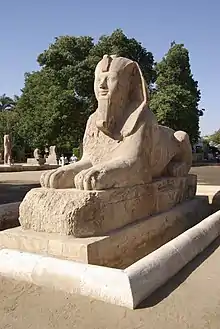| Sphinx of Memphis | |
|---|---|
 | |
| Material | Alabaster |
| Size | length: 8 m height: 4 m |
| Created | c. 1550 BC |
| Discovered | 1912 Egypt |
The Sphinx of Memphis or Alabaster Sphinx is a stone sphinx located near the remains of Memphis, Egypt. The carving is believed to have taken place between 1700 and 1400 BCE, which was during the 18th Dynasty.[1] It is unknown which pharaoh is being honored and there are no inscriptions to supply information. The facial features imply that the Sphinx is honoring Hatshepsut, or Amenhotep II, or Amenhotep III.[1][2]
Discovery
The Alabaster Sphinx was discovered in 1912 by Flinders Petrie,[3] when an affiliate from the British School in America spotted a uniquely carved object jutting out of a sand hill. It was so far in the season that excavation was useless, but a year later in 1913, further digging displayed that the object was a Sphinx's tail.[2]
Composition
The sphinx is carved from a block of alabaster, a yellowish white, soft stone, which was considered beautiful in ancient Egypt and was believed to have a mystical connection to the Sun.[4]
Physical attributes
With a length of 8 m (26 ft) and a height of 4 m (13 ft), the Sphinx of Memphis is considerably smaller than the more recognized Great Sphinx of Giza, but one of the largest monuments ever made from Egyptian alabaster.[3] At those dimensions, it is estimated to weigh around 90 tons.[1] It is supported by a foundation that makes it appear to rise out of the sand.[5] Particularly unusual about the Sphinx of Memphis are the striations on its left side, which are uncommon on Egyptian monuments.[6]
Other information
As years passed from the sphinx's creation, people ravaged Memphite temples and the Sphinx of Memphis is one of the few masterpieces that survived this pillaging.[7] During its time, this statue was also displayed near a temple in honor of Ptah. Ptah was one of the Egyptians' world-creator gods.[8]
See also
References
- 1 2 3 "Alabaster Sphinx". InterCity Oz (Interoz.com). 1996. Archived from the original on 19 April 2000. Retrieved 18 February 2011.
- 1 2 Davis, Charles H. S. (1912). "Archaeological notes". The American Antiquarian and Oriental Journal. 34 (3): 228-229, 235.
The alabaster sphinx recently discovered near Memphis is believed...
- 1 2 "The Sphinx of Memphis, 1920s". Egypt Museum. 15 October 2022. Retrieved 7 September 2023.
- ↑ "Calcite". Glimmerdream. 2003. Retrieved 4 March 2011.
- ↑ "Alabaster Sphinx". Phouka Pages. Egyptian Journey 2003: Photos: Memphis. 2003. Retrieved 18 February 2011.
- ↑ Lutz, Dick; Lutz, Mary (2007). Exploring Egypt: A traveler's view of an ancient civilization. DIMI Press. p. 97. ISBN 978-0931-62544-2. ISBN 0931-62544-0
- ↑ Shaw, Ian (1997). "Chapter 5 – The settled world". In Silverman, D.P. (ed.). Ancient Egypt. Oxford, UK / New York, NY: Oxford University Press. p. 75. ISBN 0-19-521952-X.
The New Kingdom calcite sphinx is one of the few monuments to have survived medieval pillaging of Memphite temples ...
- ↑ "Memphis [was one of] the most ancient of Egypt's capital[s]". Love Egypt. Archived from the original on 1 January 2017. Retrieved 20 October 2022.